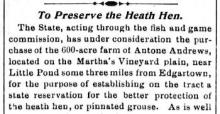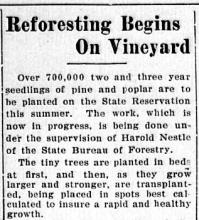George M. Moffett Jr., widely known as a yachtsman and conservationist, signed an agreement last week by which Felix Neck, more than 200 beautiful acres of widely varying terrain extending into Sengekontacket Pond, will be conveyed to the Massachusetts Audubon Society as a wildlife sanctuary. Part of the acreage is transferred immediately, and the balance will be leased to the Audubon Society until the gift is completed.
Of immediate significance, the gift makes available on the Vineyard the educational resources of the Audubon Society Which is preeminent in this field. These will be realized largely through the program of the Martha’s Vineyard Natural History Society which has been developing steadily at Felix Neck for some years past, in a close understanding with the Audubon Society and Mr. Moffett. The educational opportunities, however, will not be limited to this program and may find wider expression.
Acceptance Was Voted
Mr. Moffett, who became a summer resident of Edgartown in 1960, purchased Felix Neck in December, 1962, from Walter C. Smith Jr. At the time he told the Gazette he hoped to establish a nature preserve but had no more definite plans. The understanding with the Audubon Society has been matured since then; and the directors of the society voted some time ago to accept the gift. In 1960 Mr. Moffett bought the former Stella Dillon property on Chappaquiddick with its attractive frontage on Caleb’s Pond. He is the owner of the 49-foot yawl Guinevere in which he has competed in many ocean races since she was built in 1966.
His interest in nature, especially in birds, has taken him on expeditions during which he has made many remarkable photographs of birds in a rare intimacy in their wild surroundings. Most recently he spent considerable time in the Andes and successfully photographed the nesting habits of a pair of extremely rare Torrent Duck.
Felix Neck was formerly the Amoz Smith farm on the south side of Sengekontacket Pond. The name derives from the last of the Indians known to have lived there. The western shore borders Major’s Cove, and the shore line wanders in and out of coves roughly parallel to the State Beach on the opposite side of Sengekontacket. The coves form links among the many marshes which are among the fascinating resources of the Neck.
The pond, the sheltered coves, and the marshes are great progenitors of many forms of marine life important in ecology and for organic growth of all kinds. These are part of the varied topography which makes Felix Neck not only beautiful but also gives it very special characteristics and possibilities for conservation.
The rich promise of the Neck was suggested in an article accompanying a display of photographs in the Gazette of Nov. 29.
“There are large areas of open fields, other areas of scrubby growth with their own special forms of life,” this article said, “and the woodlands, mostly the pitch pine and oaks so typical of the Island vegetation. A number of fresh water ponds are found in the spring, sometimes lasting into early summer, but always staying damp enough to make their own contribution to the variety of plant and animal life of the Neck, in all a great variety of terrain.”
With this background the program of the Natural History Society began to take form several years ago, under the presidency of Mrs. Thomas Hale, the prime mover, with Mrs. Robert P. Goodale as treasurer, and Mrs. Dixon B. Renear who this year succeeded Mrs. Russell Hoxsie as secretary. Serving on the board are Mrs. Robert G. Potter, Mrs. Dielle Fleischmann, Mrs. Hoxsie, Mrs. John M. Mayhew Jr., Mr. Moffett, Mrs. Henry S. Patterson, Michael Straight, Mrs. Harold Wolozin, Robert E. Woodruff, Percy L. Prescott, Thomas Hale and Mrs. Daniel P. Gaines.
“First came children’s summer classes to study natural history. This was the beginning of Fern and Feather, and a treasury of summer discoveries of Felix Neck.
Land Improvements Next
“Next came the beginning of land improvement to increase the potential attractiveness of the wildlife habitats. This step followed much technical advice from the state conservation service. The scrubby growth that crept slowly into the open fields, threatening to convert them again into woodland, was cut back. Last fall, lime was spread over 50 acres of land to initiate a program of soil rehabilitation.
“More exciting developments took place this past spring. A plan for gradually bringing back the fertility of open fields was drawn, and work was begun on about 14 acres. Six strips of land were ploughed, fertilized, and seeded to plants known to attract wildlife.
“Probably the most dramatic change came when one of the seasonal ponds was deepened and became a pond-for-the-whole-year. Anxious eyes watched it through the drought of the summer. The water level held. Frogs appeared. Seventeen were caught and counted by enthusiastic youngsters in one afternoon where earlier this spring, before digging began, a group of adults had surveyed the life of the pond and found very little. . .Expectations are high that there will be a great increase in the variety of quantity of life to be found.”
Gradually Mr. Moffett and members of the Natural History Society have raised their sights, and already, the reality of a wildlife refuge has taken place. In this goal the Audubon Society is now joined through its acquisition of the Neck and its experience, knowledge, and resources. The commitment of the Society is simply to maintain the nature refuge inviolate; the program will be a Vineyard opportunity.
The Massachusetts Audubon Society, its membership far larger than that of the National Audubon Society, has made an impressive growth. Its gross budget in 1963-64 was $670,000; in 1967-68 it was $1,320,200. This past year its “cash flow” reached $3,320,105.
The Society’s annual report, distributed this month, says: “Formal
education programs - the backbone of our efforts - continue to expand - virtually all of which (school classes, summer camps, workshops, and evening adult classes) made modest attendance gains and reached new highs during the year.
“The Liberty Council, a cooperative conservation education unit federally funded for three years to serve the schools of 14 contiguous towns, is based at Drumlin Farm and continues to prove its value. . . .
“Under the staff reorganization several new staff positions were created which have materially strengthened various parts of the total education effort.”
The Society operates a Conservation Services Center, a Natural History Services with staff lectures, film rentals, publications, amateur research, tours, and field trips. A three day nature weekend was held in August at the University of Massachusetts, attracting almost 600.
A close professional and personal tie with the Vineyard has been preserved for some years through the visits to the Island of the Society’s executive vice president, Allen H. Morgan, whose friendships here are extensive, and who has aided consistently in all sorts of Island conservation projects.











Comments